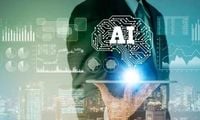In a world increasingly driven by data and digital innovation, quantum computing is emerging as a revolutionary force that could redefine the limits of human capability. According to analysts at Bank of America (BofA), this technology may represent the most significant breakthrough since the discovery of fire, a milestone that transformed early human civilization hundreds of thousands, if not a million, years ago.
Quantum computing harnesses the unique properties of subatomic particles, known as qubits, which can exist in multiple states simultaneously—a phenomenon called superposition. This allows quantum computers to perform complex calculations at speeds and scales unattainable by classical computers, which rely on binary bits of either 0 or 1. The potential applications are staggering: from creating new drugs and materials to enhancing encryption, logistics, and even increasing human longevity.
BofA’s analysts emphasize the transformative power of quantum computing, describing it as “a technology that can perform endless complex calculations in zero-time, warp-speeding human knowledge and development.” The scope of this technology is vast; theoretically, there is no calculation beyond its reach. This capability could usher in breakthroughs in multiple sectors, including healthcare, finance, and cybersecurity.
Already, quantum computing has demonstrated impressive milestones that hint at its future promise. In 2023, Google's Sycamore quantum processor completed a calculation in just six seconds—a task that would have taken the world’s top supercomputer 47 years. Later that year, Google's Willow chip solved a problem in under five minutes that would have required an estimated 10 septillion years for the fastest classical supercomputer to complete. These feats highlight the immense computational advantage quantum machines possess, though practical, real-world applications still face significant hurdles.
One of the main challenges is the issue of "noise" in qubits—random disturbances that cause errors in calculations. This instability means that, so far, quantum computers have not yet outperformed classical computers on useful, everyday problems. Tech leaders like Nvidia CEO Jensen Huang have tempered expectations, noting in early 2025 that the most exciting quantum advances are still more than a decade away. Huang also clarified that quantum computing won’t simply make tasks like spreadsheet management faster, but instead will revolutionize more complex computational challenges.
Rob Schoelkopf, cofounder and chief scientist of Quantum Circuits, echoed this gradualist perspective. In March 2025, he described the progress as turning up the volume steadily rather than flipping a switch, saying, “We’re going to be turning the volume steadily, and we can start to hear the music now, and eventually everyone will be able to hear the music.” This metaphor captures the ongoing refinement and scaling of quantum technologies as they move toward broader usability.
Beyond the technological and commercial implications, quantum computing carries profound geopolitical significance. The United States currently leads the world in processing power, but BofA warns that the “quantum race” could level the playing field. The winner of this race will gain an unprecedented geopolitical, technological, and economic advantage, reshaping global power dynamics in the coming decades.
The urgency to develop quantum computing is further heightened by its interplay with artificial intelligence (AI). Classical computing systems are nearing fundamental limits, constraining AI's ability to evolve. Training large AI models, such as GPT-3, demands enormous energy—around 1,300 megawatt-hours—and classical optimization problems require exponentially growing computational resources. Quantum computing offers a path forward, with the potential to turbocharge AI development and even propel it toward Artificial Super Intelligence.
Recent advancements in quantum-AI integration underscore this potential. Google’s Willow processor not only completed calculations at unprecedented speed but did so while consuming 30,000 times less energy than classical supercomputers. This dramatic efficiency gain is critical as AI applications expand in complexity and scale.
The quantum computing field has seen transformative progress between 2024 and 2025, signaling its move from research labs toward mainstream adoption. Google's Willow chip achieved below-threshold error correction, a key milestone that enables quantum systems to become more accurate as they scale. IBM has charted a roadmap aiming for 200 logical qubits by 2029, while Microsoft’s breakthroughs in topological qubits promise inherent resistance to errors.
Investment flows mirror this optimism. Quantum startups raised $2 billion in 2024—a 138% increase from the previous year. Major corporations are committing billions to quantum research and development: IBM with a $30 billion R&D investment, Microsoft launching a quantum-ready initiative in 2025, and Google offering a $5 million prize for quantum applications. Market projections foresee quantum computing revenues surpassing $1 billion in 2025 and soaring to between $28 billion and $72 billion by 2035.
Leading experts converge on a consistent timeline for quantum breakthroughs. IBM’s CEO predicts demonstrations of quantum advantage by 2026; Google aims for useful quantum computers by 2029; Quantinuum targets universal fault-tolerant quantum computing by 2030; and IonQ expects commercial quantum advantages in machine learning by 2027. These milestones suggest the 2025-2030 period will be pivotal, much like the internet’s explosive growth from 1995 to 2000.
Practical applications are already emerging. JPMorgan and Amazon have reduced portfolio optimization problems by 80% using quantum systems. Quantum-enhanced traffic optimization has cut congestion in Beijing by 20%. In healthcare, the Cleveland Clinic and IBM launched a dedicated quantum computer for protein interaction modeling in cancer research, while Pfizer partnered with IBM to accelerate drug discovery through quantum molecular modeling. DHL improved international shipping routes by 20% using quantum algorithms, showcasing benefits across industries.
Energy efficiency is another compelling advantage. Quantum systems consume 1,000 to 10,000 times less energy for specific computational tasks compared to classical computers, a critical factor as data centers and AI models become increasingly energy-intensive.
Security concerns also drive quantum adoption. Current encryption methods protecting AI and digital infrastructure are vulnerable to quantum attacks expected within this decade. The U.S. government has mandated federal agencies to transition to quantum-safe cryptography, and the National Institute of Standards and Technology (NIST) released new post-quantum encryption standards in 2024. Adversaries could exploit a “harvest now, decrypt later” approach, collecting encrypted data today to break it once quantum decryption becomes feasible.
Satellite-based quantum communication networks are already operational, with China’s network spanning 12,000 kilometers and similar projects launching globally. This intersection of quantum security and AI protection is set to drive widespread infrastructure upgrades in the near future.
As the world stands on this technological precipice, experts warn that the next five to six years will determine which organizations and nations successfully navigate the quantum transition. Just as companies that failed to embrace the internet in the early 2000s were left behind, those ignoring quantum computing risk losing their competitive edge in the AI-driven economy.
The quantum revolution is no longer a distant promise; it is unfolding now. AI systems must evolve to leverage quantum capabilities, requiring new algorithms and architectures that blend classical and quantum computing. This fundamental paradigm shift will reshape computation, security, and artificial intelligence, heralding a new era of innovation and challenge.
The question is not whether quantum computing will transform AI and technology, but whether society will be ready for the profound changes it brings.


